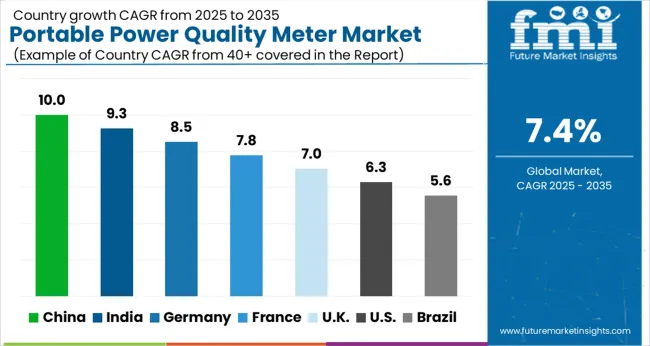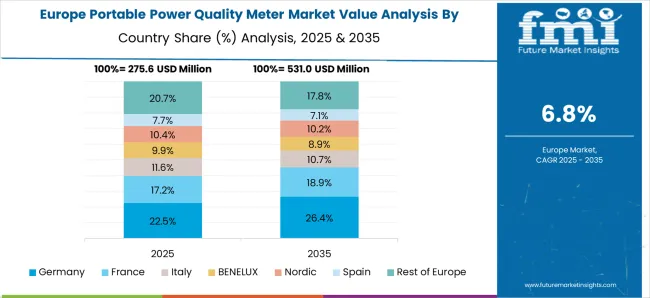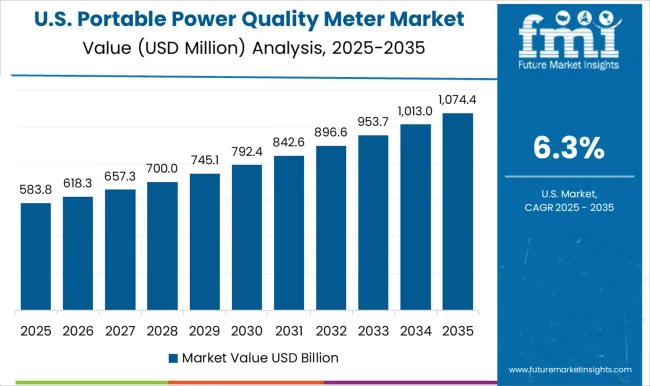The portable power quality meter market is estimated to be valued at USD 1.2 billion in 2025 and is projected to reach USD 2.4 billion by 2035, registering a compound annual growth rate (CAGR) of 7.4% over the forecast period.
his growth reflects the rising importance of monitoring electrical performance across industries, utilities, and commercial facilities to ensure efficiency, reliability, and compliance with quality standards. Between 2025 and 2030, demand will be supported by greater adoption in manufacturing plants and data centers, where downtime prevention and energy optimization are critical, driving the market beyond USD 1.7 billion.
From 2030 to 2035, the market trajectory is expected to strengthen further as renewable energy integration, grid modernization, and electric mobility expand the need for portable testing and diagnostic tools. The absolute increase of USD 1.2 billion highlights the crucial role of these meters in detecting harmonic distortion, voltage fluctuations, and power interruptions across various environments. Competitive differentiation will rely on advanced features such as wireless connectivity, real-time analytics, and compact ergonomic designs. With Asia-Pacific expected to lead in new deployments and North America and Europe emphasizing grid reliability, portable power quality meters are positioned as essential tools in the global electrical measurement ecosystem.
Manufacturing facility maintenance departments encounter diagnostic challenges as portable power quality meters must identify harmonic distortion sources, voltage sag events, and power factor issues while coordinating with production teams about equipment shutdown requirements and process impact assessment. Electrical technicians work with maintenance supervisors to establish measurement protocols that address both immediate troubleshooting needs and long-term trend analysis while managing documentation requirements for insurance claims, warranty investigations, and regulatory reporting procedures.
Cross-functional coordination between facility management teams and electrical contractors creates ongoing dialogue about power quality monitoring versus operational continuity requirements. Maintenance planning departments work with operations managers to schedule comprehensive power quality surveys while managing production scheduling constraints and equipment access limitations that may affect both measurement accuracy and operational efficiency across diverse facility types and electrical load characteristics.
Data center operations experience measurement complexity as power quality assessment requires coordination between critical power systems, uninterruptible power supply monitoring, and environmental control systems while maintaining continuous operations and redundancy requirements. Technical operations teams coordinate with power quality specialists to establish monitoring procedures that address both immediate fault detection and predictive maintenance indicators while managing data logging requirements and analysis procedures that support both operational decisions and capacity planning initiatives.
| Metric | Value |
|---|---|
| Portable Power Quality Meter Market Estimated Value in (2025 E) | USD 1.2 billion |
| Portable Power Quality Meter Market Forecast Value in (2035 F) | USD 2.4 billion |
| Forecast CAGR (2025 to 2035) | 7.4% |
The portable power quality meter market is gaining strong momentum due to the increasing focus on energy efficiency, infrastructure reliability, and the need to minimize power disruptions across industries.
The rise in distributed energy resources, electric vehicle integration, and complex power electronics in commercial environments has fueled the demand for accurate, portable monitoring solutions.
These meters enable real-time diagnostics and analysis of voltage, current, and frequency disturbances, helping operators maintain stable and efficient electrical systems.
Regulatory compliance with international power quality standards, coupled with the growing emphasis on preventive maintenance and system optimization, continues to drive widespread adoption.
Technological advancements such as enhanced data logging, connectivity, and user interface capabilities are improving operational efficiency and usability.
Organizations are recognizing the importance of flexible, high-precision portable tools to ensure reliability across diverse operational environments, leading to sustained market growth.
The portable power quality meter market is segmented by application and geographic regions. By application, the portable power quality meter market is divided into commercial, industrial, and utility. Regionally, the portable power quality meter industry is classified into North America, Latin America, Western Europe, Eastern Europe, Balkan & Baltic Countries, Russia & Belarus, Central Asia, East Asia, South Asia & Pacific, and the Middle East & Africa.
The commercial segment is projected to hold 47.3% of the total market revenue by 2025, establishing itself as the leading segment. This dominance is supported by the growing adoption of sensitive electronic equipment in data centers, office complexes, and retail facilities, where even minor power disruptions can lead to significant operational and financial losses.
Increasing implementation of energy audits, efficiency benchmarking, and demand-side management programs has accelerated the need for portable power quality meters. Facility managers and energy consultants rely on these instruments to detect anomalies, balance loads, and optimize electrical performance.
As the commercial sector continues to expand its use of automation and digitized building systems, power quality monitoring tools are becoming essential for ensuring uptime and cost efficiency, reinforcing the segment’s market leadership.
The market is primarily driven by the growing emphasis on energy optimization, regulatory compliance, and the expansion of industrial and commercial infrastructure. The increasing integration with smart grids and real-time monitoring systems represents a key advancement shaping market trends.
Rising industrialization and digitalization have created an urgent need for precise, real-time power monitoring. Portable power quality meters allow users to measure key electrical parameters, voltage, current, frequency, and harmonics, to ensure stable operations. They are widely adopted in industries seeking to prevent equipment damage, reduce downtime, and improve energy utilization.
As energy costs rise, companies are prioritizing power quality control as part of broader efficiency and reliability strategies, reinforcing market demand for portable monitoring solutions.
Strict government regulations and industry standards now mandate regular monitoring and reporting of power quality metrics. Utilities and industrial users employ portable power quality meters to ensure that systems meet these benchmarks, avoiding penalties and operational risks.
Compliance-driven adoption is particularly high in manufacturing, energy generation, and utilities, where consistent monitoring is crucial for maintaining safety and reliability.
The continued expansion of industrial facilities, commercial infrastructure, and smart buildings is a major driver of market growth. These sectors depend on accurate portable power quality meters to detect issues, prevent costly failures, and improve energy distribution. The versatility and portability of modern meters have made them indispensable in both onsite diagnostics and preventive maintenance operations.
The integration of portable power quality meters with smart grid networks is transforming power management. Modern meters can transmit real-time data to centralized monitoring systems, enabling predictive maintenance, fault detection, and energy optimization. This evolution supports more intelligent grid operations and positions portable meters as key components in next-generation energy infrastructure.

| Country | CAGR |
|---|---|
| China | 10.0% |
| India | 9.3% |
| Germany | 8.5% |
| France | 7.8% |
| UK | 7.0% |
| USA | 6.3% |
| Brazil | 5.6% |
The portable power quality meter market is projected to grow globally at a CAGR of 7.4% from 2025 to 2035, driven by increasing demand for energy-efficient solutions, grid optimization, and regulatory standards emphasizing power reliability. China leads with a 10.0% CAGR, followed by India at 9.3%, while France, the UK, and the USA show steady expansion supported by modernization of energy infrastructure. This analysis spans more than 30 countries, with these six serving as key benchmarks for growth, innovation, and investment planning across the global portable power quality meter market.
China is projected to record a 10.0% CAGR for 2025–2035, exceeding the global average of 7.4%. Between 2020 and 2024, growth stood at 7.2%, driven by rapid industrialization, expanding energy consumption, and the increasing need for high-precision monitoring in manufacturing and infrastructure projects.
Looking ahead, government initiatives promoting energy efficiency, grid modernization, and renewable integration will further strengthen demand. As industrial and urban power systems become more complex, portable power quality meters are emerging as critical tools for maintaining system reliability and minimizing downtime.
India is expected to grow at a 9.3% CAGR between 2025 and 2035, above the global average. During 2020–2024, the market grew at 7.5%, supported by infrastructure expansion, frequent power fluctuations, and rising emphasis on energy management.
Government programs aimed at grid stability, industrial modernization, and sustainable power distribution continue to fuel adoption. The increased focus on digital metering and on-site diagnostics is helping industries minimize operational losses and enhance power reliability.

France is projected to grow at a 7.8% CAGR from 2025 to 2035, outpacing the global average. Between 2020 and 2024, the market expanded at 5.6%, supported by stricter energy regulations and the integration of renewable energy sources into national grids.
The ongoing energy transition policies in France are prompting utilities and industries to adopt portable power quality meters to monitor grid stability and ensure compliance. The push toward cleaner energy and modernization of existing electrical networks is expected to keep demand high in the coming decade.
The United Kingdom market is forecast to grow at a 7.0% CAGR from 2025 to 2035, slightly below the global baseline of 7.4%. Growth during 2020–2024 stood at 5.2%, driven by efforts to enhance energy efficiency, grid resilience, and industrial productivity.
The ongoing transition toward green energy solutions and rising adoption of real-time monitoring tools are further supporting the market. Portable power quality meters are increasingly used for preventive maintenance and system optimization in commercial, industrial, and public utility applications.

The United States market is expected to expand at a 6.3% CAGR from 2025 to 2035, slightly below the global trend. Between 2020 and 2024, the market recorded 5.1% growth, supported by ongoing infrastructure upgrades and increasing regulatory attention to power reliability.
Future growth will be driven by grid optimization projects, renewable energy integration, and maintenance digitization across utilities and manufacturing. Portable power quality meters will remain vital for ensuring compliance, improving uptime, and reducing power-related losses across industries.
The portable power quality meter market is defined by strong competition among global electrical instrumentation leaders and specialized monitoring solution providers, offering advanced tools for power diagnostics, energy efficiency, and grid reliability. ABB Ltd., Delta Electronics, Inc., Eaton Corporation plc, Fluke Corporation, Siemens AG, and Schneider Electric SE dominate the market, each leveraging technological innovation, measurement precision, and smart integration to serve diverse industrial and commercial sectors.
ABB Ltd. leads with a comprehensive range of portable and fixed power quality analyzers, designed for industrial automation, utilities, and infrastructure applications. Its solutions emphasize digital connectivity, ease of deployment, and high-accuracy diagnostics. Delta Electronics, Inc. delivers energy-efficient, portable power quality meters that support real-time energy management, harmonics analysis, and grid optimization, helping users enhance system performance and reliability. Eaton Corporation plc focuses on energy-efficient monitoring devices that allow customers to analyze consumption trends, mitigate power disturbances, and improve electrical system performance.
Fluke Corporation is recognized globally for its rugged, user-friendly, and highly portable testing instruments, offering advanced features such as harmonics detection, waveform capture, and real-time event logging. Siemens AG integrates its power quality meters within smart grid and digital substation systems, enabling real-time monitoring, predictive maintenance, and automated fault analysis. Schneider Electric SE emphasizes intelligent energy management solutions and connected power quality meters, catering to industrial automation, commercial buildings, and utility networks with a strong focus on sustainability and predictive analytics.
Among other notable players, Accuenergy Ltd., Dranetz Technologies, Inc., Elspec Ltd., General Electric Company, Mitsubishi Electric Corporation, PCE Holding GmbH, Rishabh Instruments Limited, Vitrek, LLC, and M B Control & Systems Pvt. Ltd. provide high-performance instruments with specialized features such as high-frequency transient capture, cloud-based data logging, and wireless connectivity. These companies focus on accuracy, portability, and interoperability, enhancing diagnostic capability across industries such as manufacturing, utilities, data centers, and transportation.
Competitive strategies in the portable power quality meter market increasingly revolve around expanding product portfolios, integrating IoT-enabled monitoring, and strengthening after-sales service networks. Key players are also investing in AI-driven analytics and predictive maintenance capabilities, ensuring faster response times, greater operational uptime, and improved energy efficiency. As global demand for smart power management and grid reliability continues to rise, innovation in compact, connected, and field-ready power quality analyzers is expected to remain the primary growth driver through 2030.
| Item | Value |
|---|---|
| Quantitative Units | USD 1.2 Billion |
| Application | Commercial, Industrial, and Utility |
| Regions Covered | North America, Europe, Asia-Pacific, Latin America, Middle East & Africa |
| Country Covered | United States, Canada, Germany, France, United Kingdom, China, Japan, India, Brazil, South Africa |
| Key Companies Profiled | ABB Ltd.; Accuenergy Ltd.; Delta Electronics, Inc.; Dranetz Technologies, Inc.; Eastron Electronic Co., Ltd.; Eaton Corporation plc; Elspec Ltd.; Emerson Electric Co.; Fluke Corporation; General Electric Company; M B Control & Systems Pvt. Ltd.; Megger Group Limited; Mitsubishi Electric Corporation; PCE Holding GmbH; Rishabh Instruments Limited; Schneider Electric SE; Siemens AG; Vitrek, LLC. |
| Additional Attributes | Dollar sales projections, market share of key players, and growth drivers such as increasing energy consumption, regulatory mandates, and demand from industrial sectors. |
The global portable power quality meter market is estimated to be valued at USD 1.2 billion in 2025.
The market size for the portable power quality meter market is projected to reach USD 2.4 billion by 2035.
The portable power quality meter market is expected to grow at a 7.4% CAGR between 2025 and 2035.
The key product types in portable power quality meter market are commercial, industrial and utility.






Our Research Products

The "Full Research Suite" delivers actionable market intel, deep dives on markets or technologies, so clients act faster, cut risk, and unlock growth.

The Leaderboard benchmarks and ranks top vendors, classifying them as Established Leaders, Leading Challengers, or Disruptors & Challengers.

Locates where complements amplify value and substitutes erode it, forecasting net impact by horizon

We deliver granular, decision-grade intel: market sizing, 5-year forecasts, pricing, adoption, usage, revenue, and operational KPIs—plus competitor tracking, regulation, and value chains—across 60 countries broadly.

Spot the shifts before they hit your P&L. We track inflection points, adoption curves, pricing moves, and ecosystem plays to show where demand is heading, why it is changing, and what to do next across high-growth markets and disruptive tech

Real-time reads of user behavior. We track shifting priorities, perceptions of today’s and next-gen services, and provider experience, then pace how fast tech moves from trial to adoption, blending buyer, consumer, and channel inputs with social signals (#WhySwitch, #UX).

Partner with our analyst team to build a custom report designed around your business priorities. From analysing market trends to assessing competitors or crafting bespoke datasets, we tailor insights to your needs.
Supplier Intelligence
Discovery & Profiling
Capacity & Footprint
Performance & Risk
Compliance & Governance
Commercial Readiness
Who Supplies Whom
Scorecards & Shortlists
Playbooks & Docs
Category Intelligence
Definition & Scope
Demand & Use Cases
Cost Drivers
Market Structure
Supply Chain Map
Trade & Policy
Operating Norms
Deliverables
Buyer Intelligence
Account Basics
Spend & Scope
Procurement Model
Vendor Requirements
Terms & Policies
Entry Strategy
Pain Points & Triggers
Outputs
Pricing Analysis
Benchmarks
Trends
Should-Cost
Indexation
Landed Cost
Commercial Terms
Deliverables
Brand Analysis
Positioning & Value Prop
Share & Presence
Customer Evidence
Go-to-Market
Digital & Reputation
Compliance & Trust
KPIs & Gaps
Outputs
Full Research Suite comprises of:
Market outlook & trends analysis
Interviews & case studies
Strategic recommendations
Vendor profiles & capabilities analysis
5-year forecasts
8 regions and 60+ country-level data splits
Market segment data splits
12 months of continuous data updates
DELIVERED AS:
PDF EXCEL ONLINE
Power Quality Meter Market Size and Share Forecast Outlook 2025 to 2035
Energy & Power Quality Meters Market Growth - Trends & Forecast through 2034
Power Quality Equipment Market Size and Share Forecast Outlook 2025 to 2035
Power Metering Market
Portable Power Station Market
Portable Audiometer Calibration System Market Size and Share Forecast Outlook 2025 to 2035
Portable Battery-powered Products Market Analysis by Growth, Trends and Forecast from 2025 to 2035
Portable Hydrogen Powered Generator Market Size and Share Forecast Outlook 2025 to 2035
India Power Metering Market Insights – Trends & Forecast 2025 to 2035
Portable Multi-Parameter Monitors Market
Portable NIR Moisture Meter Market Forecast and Outlook 2025 to 2035
Diesel Powered Portable Conventional Gensets Market Size and Share Forecast Outlook 2025 to 2035
Digital Power Meter Market Growth - Trends & Forecast 2025 to 2035
Cycling Power Meter Market Growth - Trends & Forecast 2025 to 2035
Plug In Power Meter Market
Optical Power Meter Market
Automated Power Meter Market Growth – Trends & Forecast 2024-2034
Microwave Power Meter Market
Comprehensive Management Solution for Power Quality Market Size and Share Forecast Outlook 2025 to 2035
Power Grid Fault Prediction Service Market Size and Share Forecast Outlook 2025 to 2035

Thank you!
You will receive an email from our Business Development Manager. Please be sure to check your SPAM/JUNK folder too.
Chat With
MaRIA